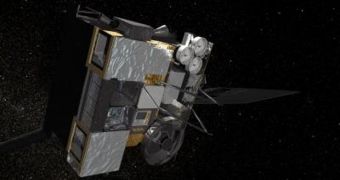Scientists in charge of operating the Geostationary Operational Environmental Satellite (GOES-14), formerly known as GOES-O, say that all the instruments on the spacecraft are working well, and that it is currently being moved to an on-orbit storage location. The satellite is now awaiting deployment, after mission managers have confirmed that the craft is in good shape, and ready to do science. The maneuvers are partially necessary to maintain the ship's orbit, the mission managers add.
“The GOES-14 (O) Post Launch Test phase continues with the specification testing of the Image Navigation and Registration (INR) System and performance is excellent. The fall eclipse season has come to an end and the power and thermal performance was exactly what we expected,” explains Andre Dress. The expert is the GOES N-P Deputy Project Manager, and he is based at the NASA-operated Goddard Space Flight Center, in Greenbelt, Maryland.
GOES-14 experiences eclipses two times every year, around the spring and autumn equinoxes. During these times, the sunlight reaching the spacecraft is blocked by Earth's shadow, which engulfs the satellite for about 72 minutes out of its 24-hour orbit period. The eclipses last for 45 days each, for a total of 90 days each year. GOES-14 is currently being moved at the rate of 1 degree per day, Mission Control announced. It has to reach 105 West longitude over the central United States, from its current position of 90 West longitude.
After it reaches its established location, it will be handed over to the National Oceanic and Atmospheric Administration (NOAA), which will continue to operate the satellite for collecting data on Earth's weather patterns. The spacecraft is part of a larger network operated by NOAA, whose goal is to provide a broad coverage of atmospheric events taking place around the globe. The spacecraft was launched aboard a Delta IV-M delivery system, from Space Launch Complex 37B at the Cape Canaveral Air Force Station, in Florida. Takeoff occurred at 22:51 GMT, on June 27, 2009.

 14 DAY TRIAL //
14 DAY TRIAL //